May 26 My worries about the beavers having left the pond were misplaced. I went down before dinner not expecting to see a beaver, but one was out in the middle of the pond. It swam right over toward me as I sat in the chair by the dam.
It came closer than it ever has, its nose working to catch my scent.
It turned away seemingly relax. Its tail was not cocked to slap the water.
Then it swam back in front of me and went over to the shallows to my right and brought up a root to gnaw. Then it swam over to knoll well to the right of the lodge and when it disappeared under the shrubs overhanging the pond I thought I heard beaver whining. I assumed the other beaver was already there.
I waited as long as I could hoping to see them both swim out. Instead, I was entertained by a muskrat.
The cocked tail of the munching muskrat is a characteristic pose I always enjoy. Dinner ran a bit late and when I got back down to the pond I saw both beavers swimming and took video which is too dark to share. Unfortunately both of them were aware of and seemingly concerned by my presence, but there were no tail slaps. Each would sniff me and swim back and forth in front of me and then they seemed to confer a couple times swimming a tight circle around each other almost nose to nose. My interpretation is that the larger beaver, and longer resident of the pond, is still reassuring the new beaver that I am OK despite how alarming I might smell. There are reasons for the beavers to be wary. I am likely the only human bothering them but coyotes are surely in the area, and perhaps bobcats.
May 27 Since we may be away from mid-September to February and hence will need less firewood, instead of collecting wood as I usually do at this time of year, I’ve been cutting trails. We will stay at our land every night for at least 8 weeks this summer when we have renters in our house on the island and I have long had the goal to create a system of trails that will provide a good walk of at least a half hour. So I have been cutting back the honeysuckle and buckthorn and clearing fallen trees (not many of the latter.) But what good are trails without sights to see along the way. We have long admired what we call our ripple rock trail which parallels Grouse Alley which is on the other side of the sandstone ridge that has the ripple rocks. The ripples etched by ancient waves in the stone face at a few spots along the ridge had been rather hidden by honeysuckles. Now I have a long wall exposed.
Not the Grand Canyon but no crowds of people and free admission. The Ripple Rock Trail leads down to the what we call our central valley which is not only overgrown with vegetation but, as I found out when I cut a small honeysuckle, has veery nests along the ground. I didn’t stay long enough to take a photo and hurried away as fast as I could. Of course, the valley path leads down to the Last Pool. I took a photo to confirm once again that the better drainage in the area thanks to the beavers dredging channels is going to keep what pool of water remains rather small and overgrown with grasses.
I have a way of measuring the amount of water, how much light can be seen through the tunnel they dug under trees roots so they could swim underwater up into the Last Pool.
Here is a July 21, 2009, photo (lpchana) showing how it looked in mid-summer when the beavers were here and dredging so much the water was always muddy.
To be sure the once shaded wet areas are quite fertile and greening with the sun’s energy and the main channel that the beavers always dredged may turn into an interesting venue for wildlife and this area is certainly more accessible and easier to see thanks to the beavers.
The many small stumps, mostly of hornbeams, mark where a major impediment to walking had been.
Among the current crop of beaver enthusiasts there is much talk about beavers coppicing vegetation suggesting that their cutting trees and bushes will lead inevitably to more trees and bushes. The hornbeam stumps that were flooded for a couple years have not gotten the message. The winterberry has
Which is good for me because Leslie always complains that the beaver cut the winterberry that she enjoys. After lunch I scouted the western reaches of our 52 acres to see what trail work had to be done there. I went down the new Granite Rock Trail and then angled back up the ridge and took the trail I used to haul out logs last year from the long boundary of our land. Then I went up to the Lonesome Pine which looms high over the Deep Pond. Now that the leaves are out there is not much view but there is entertainment enough looking down in the woods.
I first heard and then caught fleeting glimpses of a scarlet tanager. Then I saw it on a tree not far below me but it flew off before I could take a photo. While I do need to mark a safe trail down the rocky ridge to the pond below, I save that for another day. I walked to the east trying to find a good way to the Hemlock Cathedral. I did find a clearing in the woods created by a huge hemlock and a huge poplar that marked an easy climb up the ridge. When I got up to the Hemlock Cathedral, I scared a grouse off her nest. This was in an open area so even after I retreated I could get a photo of the eggs.
When I sat to enjoy the calming influence of the tall hemlocks, I noticed a curious insect that crawled over toward my boot.
From the Hemlock Cathedral it's easy getting down to Boundary Pond which I did. I didn’t take my usual photo of the dam and diminished pond. I sat in the shade of the remaining hemlocks on the east shore and enjoyed the bird songs, including a peewee's call. Back in the days when I watched the beavers here, I always heard the peewee in the spring. The only bird I clearly saw was a blackbird getting bugs. There was a very loud warbler or perhaps a melodious wren high in the trees behind me.
May 28 While it is easy getting up to the Hemlock Cathedral from Grouse Alley and Boundary Pond, the trail from our house up the ridge that overlooks the gravel road that forms the north boundary of our land was completely over grown with honeysuckle bushes. After much clipping up the old trail, I gained the plateau and the peaceful clearings where I was pleased to see that one of the bogs still had water in it.
Since black flies were not bad at all this spring and mosquitoes haven’t reached their usual ferocity, I felt more at ease around this breeding ground for bugs. I even sat next to it and waited for the frogs that jumped in the water to resurface.
Some frogs were well camouflaged, for example, I think there is a smaller frog lower in the water next to the frog in the photo above.
I assume these are wood frogs but I’ll have to check the books about that. The larger bogs on the plateau are dry.
Of course one could run all around under the tall trees for exercise. I tried to get a feel for an interesting route passing must see trees but I didn’t figure anything out and the photos I took of the bigger trees showed nothing of their beauty. It’s impossible to get a picture of them from a distance that shows their character. What I need to do is build a tree fort…. When I resumed cutting the trail I was working on, a hornet persuaded me to cut a detour. I had to admire the charming setting of its neat spherical hive.
I also liked the subtle shading of the hive.
I was also reminded to be careful when cutting honeysuckles. The biggest of the bogs drains down by a sandstone ridge and I noticed a perfect jumble of rocks for a porcupine.
I saw porcupine poop in the cave shown in the photo above and when I climbed up on the rock and looked down in a cavern.
In the afternoon I tried to figure out where the beavers go when they go into the bushes screening the knoll in the Deep Pond. I have a trail up and over the knoll which needs a good bit of work but coming from the low west shore of the pond I managed to get up to where I could look down through the honeysuckles and other vegetation. I saw that there was a strip of bark taken off a big ironwood near where I stood.
But I saw no more signs of beaver work where I was. I managed to get an angle on the shore below and saw that the beavers had cleared a nice area about 3 foot square where two beaver could relax plus there appeared to be trail radiating off that seat.
I couldn’t see any nibbled sticks but perhaps I was too far away. When I came back down to the west shore of the pond, I took another photo of their hideaway from that angle.
One of the first beavers who moved into this pond after we bought our land used to climb up and sleep on the bank of the knoll during the day. Back then, 10 years ago, the vegetation was not as thick.
May 31 rainy and hot weather kept me sedentary, doing home chores. This evening I headed off to check the island beaver ponds winding up at the East Trail Pond when the beavers might be out. Of course there is nothing special about beaver ponds this time of year. The birds are what’s happening. Up on the plateau at the beginning of Antler Trail, a killdeer made sure I saw it. I assume it was trying to decoy me from some fledges nearby. Then as I approached the Big Pond dam, I sent a wood duck family in flightless panic. The ducklings scrambled to get behind their mother (one almost left behind) and seemed to form a circle behind her.
She led them on a serpentine course until they got to some water clear of surface vegetation and they lined up behind her.
There seemed to be complete complement of ducklings.
The shallow beaver-less Big Pond is being closed in by vegetation.
I don’t recollect this pond ever going completely dry. I vaguely recollect seeing it when it was an abandoned field but it is possible that in that memory I am mistaking it for fields farther to the east, up pond in the photo below. While I would prefer that beavers return and restore the pond, which I don’t think would take too much effort, I wouldn’t mind seeing it completely dry so I could see how the beavers dredged it over the years. A couple of times in the spring when there was a deep hole in the dam the pond shrank to the original creek, but each time the beavers patched the hole too soon for me to get on dry ground to allow for exploration. And the summer we had a bad drought, I was so fascinated with other dry ponds, especially the Lost Swamp Pond, that I didn’t take photos of the Big Pond then, at least I haven’t found any photos. Anyway, the photo below suggests that the pond may soon resolve itself into several pools and from that I might better reconstruct its history.
While all dams remain very fertile, at this point in the spring, the dam has dead vegetation from last year while the new green grasses are growing in what had been the pond.
Over the years the beavers have spent more time along the north shore but it is that side of the pond which is sprouting out with the most grass, while the south side continues to hold water.
By building up the dam every year the beaver kept a comfortable depth through out the pond. As I approached the Lost Swamp Pond, an osprey flew off, first time I’ve seen one here. When I got to the rock overlooking the mossy cove latrine, the first thing I saw was the pond weed shooting above the water in the shallow pond below.
The vegetation is claiming more of the shallower northeast end of the pond.
The pond behind the dam looks quite full but looks can be deceiving.
I waited for something to happen but nothing did. I didn’t wait long because I realized I was a bit behind schedule. As I walked around the pond to the dam some fundamentals applied. A turtle had buried eggs and a raccoon had dug them up and eaten what was inside.
Before I blamed the diminished pond on the hole the otters put through the dam two winters ago, but that area seems to have healed, so to speak. There is a leak in the middle of the pond, very hard to see, which is keeping the pond low.
The old otter hole almost looks tended, but not by a beaver. Maybe a turtle climbed up there and flattened it after scraping some of the dirt.
One virtue of big ponds is that they keep water for a long time despite holes in dams and droughts. Small ponds can go dry quickly, as I could see below the Lost Swamp Pond dam. The Upper Second Swamp Pond dam is fast becoming a puddle.
But there is much to study in a dry pond. I have not learned to identify turtle tracks but the trail below looked like it might fit a Blanding’s turtle.
Behind the dam there was a little mud island with heron tracks and the island was flanked by two troughs of muddy water. This is a favorite pond for snapping turtles or were the troughs dredged by beavers years ago?
Looking down the dam, I saw more troughs, some with water and some dry.
I don’t recollect seeing patterns like this in other drying ponds. I have seen otters make troughs in the mud of drying ponds, but I certainly haven’t seen other otter signs around here for a long time. Looking up pond there is still water to be seen and thick low vegetation. I hope to explore that too since I think it best replicates how the area that became the Lost Swamp Pond looked before the beavers flooded the area back in 1987.
I confess to being fascinated with dried out beaver ponds. Many that I have pondered have been restored when beavers returned. In 4 or 5 years I hope beavers are back in this pond. Other than seeing some white geraniums blooming there was nothing of note to report on my way to the East Trail Pond. As I crossed the old boardwalk that now crosses dry meadow, I took a photo looking up at the beaver pond which shows no great contrast with the terrain around it. Everything is lush.
Looking back down toward the old dam, the near meadow looked a bit dry but there is vibrant green around the pool behind the old dam.
The beavers here haven’t been in the habit of gnawing bark near the dam but today I saw a stripped branch just behind the dam.
There is a tree trunk on the south shore that the beavers have been working on for last few weeks. It looks completely stripped now.
I sat high up on the granite ridge north of the pond and soon saw a muskrat swimming around the beaver lodge, but I didn’t see it swim in the lodge, an important point because from last week’s observation I concluded that the beavers kicked the muskrats out of the lodge and they had moved into a bank burrow on the south shore. Then I saw something black on the south slope and zoomed in with my camcorder and saw that it was a beaver grazing on the grass there.
As usual while keeping an eye on that beaver, I looked for others out in the pond. Unfortunately just as I thought I spotted one, a noisy hiker walked around the west end of the pond and when he got near me I saw that he was the border patrol and he had his radio tuned to a commercial radio station. Plus he asked if “I was getting good pictures?” At least he didn’t ask if I was a terrorist. The upshot of it was that I momentarily lost track of the beavers and when I refocused on the pond, I saw that the beaver on the bank was gone. A few minutes later I saw big ripples under one of the clumps of shrubs in the pond below me, then a beaver materialized in the middle of the pond. The best I could tell it was gobbing vegetation it brought up from below. Then it dove and surfaced closer to me and made an easy swim in my direction suggesting it knew I was up there.
It didn’t slap its tail and then my and perhaps its attention were diverted by another beaver that swam quickly into view about 30 yards away closer to the lodge.
The beaver below me swam closer to the other beaver that soon dove under water and they both wound up around another clump of shrubs.
I thought the second one I saw kept looking up at me and didn’t look at ease while the other placidly kept diving and bringing up things to eat, first grass and then a stick.
As I walked home to dinner I debated whether I saw three beavers or just two. I also got the impression that a beaver swam under water into the lodge but that’s an impression I’d like to get because it suggests that a mother and kits are inside and being fed. The next time I come I will have to find a better spot to sit even though I get good photos from the ridge and with the shrubs in the pond greening it is tough to get a good view by sitting lower and closer to the pond.
As I left the ridge overlooking the pond I saw digging in what little dirt there is over the granite.
There were no broken eggs about so I assume this was a case of turtles not finding a spot to lay eggs rather than raccoons looking for eggs. The latter always seem to sniff out the right place to dig. I also saw deer on my walk home. They have their reddish brown coats now.
June 2 it rained yesterday and this morning keeping my walks confined to road and ponds. As I stood scowling at the beaver pond wishing that these beavers would leave more signs of their activity I noticed some bare ground on the high bank that forms the east shore of the pond. I had seen beavers eating grass up on that bank and then I saw that there was an animal up on the bank.
It looked like a snapping turtle to me so I had to walk around the pond braving the damp vegetation. Unfortunately before I got to the turtle, she plopped back into the pond and swam underwater over toward the knoll. I did get a photo of the hole she left. There were no eggs in it.
Since I was over there I took a photo of the shallow area where the beavers do much of their nibbling. It looked about the way it always has but the dark damp day made for a more alluring photo.
As usual I looked around for trees the beavers might have cut or started to cut, and as usual I saw none. I took a photo of the dam. Taken from that far behind it, one can see how much the water level has dropped and conversely how well the beavers built up the dam.
I also checked the Third Pond where there was nothing new to report and the Teepee Pond where I saw witch’s butter, I think they call it, in one of the cedar trees.
We’ve had enough rain to excite the fungi. At the moment they are colonizing the logs rather than popping out of the ground.
Usually we always spend Saturday nights at our land but since we are going away tomorrow morning for 5 days, we stayed on the island. Thanks to that we saw a golden eye mother and her raft of rather excited ducklings.
Golden eyes winter here and we’ve never noticed one nesting. But this winter Leslie noticed that some kept flying up in the tree on Goose Island. This evidently was the upshot of that. Unlike other ducks, the mother did not look for a secluded spot and calm water. I think they were catching midges and other water bugs to eat. Plus the mother kept showing the ducklings that they were diving ducks not just bug pickers.
June 9 we got back home yesterday and went to the land today to pick what we could out of the garden. Of course my labors are very marginal when it comes to picking so I had time to walk around. I ducked down to check on White Swamp and the pond the beavers have been using where the creek from the Deep Pond enters the big swamp. I got the impression that no beaver had been foraging along the shallow west shore of that pond, though I got a neat photo of a line of trees cut by beavers that all fell away from the center of the pond. Usually it is the opposite.
However looking over at the east shore of the pond where the creek runs and the water is deeper, I couldn’t say for sure that beavers aren’t foraging there where saplings and trees are more accessible. I didn’t walk over to check, not an easy trek, and I thought I could easily tell if beavers were still in the area by checking the lodge along the south shore of the swamp. I went up and over the ridge to get to it. I saw no nibbled sticks along the shore east of the lodge, where I had seen some before. However, the water lilies are already blooming in the swamp. So far there are not nearly as many along this shore as a few years ago, but there are some.
Beavers could be feasting on lily roots here still. However the lodge didn’t show any signs of recent activity.
Then when I walked around to the west side of the lodge, I saw a fresh scent mound up on the shore, likely left by a beaver.
As I stood contemplating that I heard a ruckus down in the swamp to my left and saw a wood duck family scramble for safety. As always the mother led the way, and her three ducklings seemed cool at first as they followed. But when they lost sight of her, they panicked and churned water to follow.
Then another duckling materialized and seemed to have some trouble finding the right way through the low shrubs.
On the way back to the house, I decided to kill some of the time until dinner and sit on the chair by the Deep Pond dam and ponder. Since it was only 4:17 pm, I didn’t expect to see beavers, but when I sat down I saw one swimming in the middle of the pond. I saw something swimming close behind it and for an instant thought it was a baby beaver tagging along but it turned out to be the other adult beaver. They swam toward me and then turned toward the east shore of the pond. There was a light wind in my face so I don’t think they smelled me. They swam close together but with no suggestion of flight and pursuit.
They stopped paddling as they reached the shore and drifted to a stop. One dove and brought up a root to eat and the other swam over to the far shore of the pond. The root eater soon followed, chewing along the way.
They were soon nose to nose again, briefly, and one dove, the other swam aimlessly, and then they were nose to nose again before swimming in opposite directions.
The fur on the top of the head of the smaller beaver is often sticking up in a somewhat wild fashion. I saw it shake its head and instantly the fur smoothed from diving went wild again.
The smaller beaver swam over to the west shore, went up on it and cut some meadow sweet, I think, and dragged it back in the water and methodically ate every leaf.
Then it swam over to the bank lodge and chewed on something, probably a root.
I had lost track of the larger beaver then soon saw it swimming out of the inlet. It swam directly to the lodge where the other beaver was under water. When it surfaced the beavers were briefly nose to nose again. Then once again they swam side by side away from the lodge, but one beaver quickly dove.
When the one was almost over to where I was sitting, the other surfaced in front of the lodge. I rather enjoyed their relaxed togetherness, often separating but frequently getting back together. I had been thinking these two beavers were deficient because they weren’t cutting and hauling big trees. Now I can see that that is dangerous work, enforcing separation and perhaps a measure of resentment in the one doing most of the gnawing. The many small meals of these beavers might make for a more pleasant society, though it robs me of my usual photos of beaver heroics.












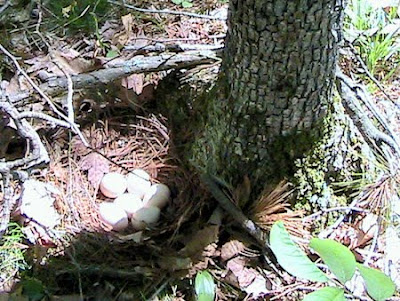







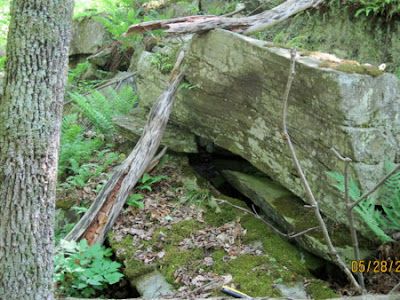









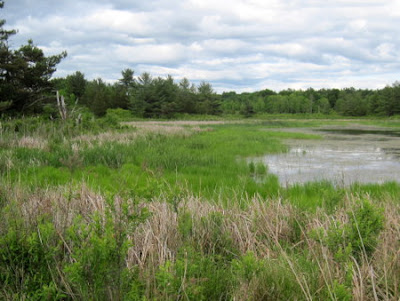

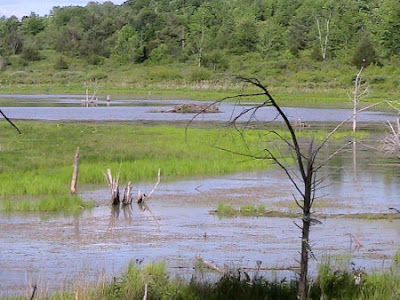



























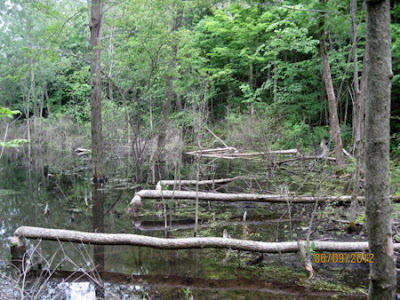




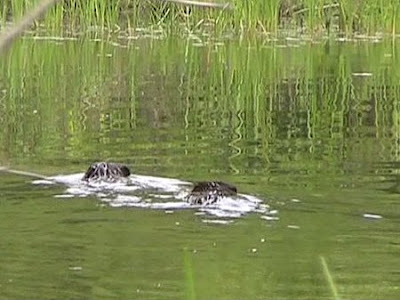





No comments:
Post a Comment